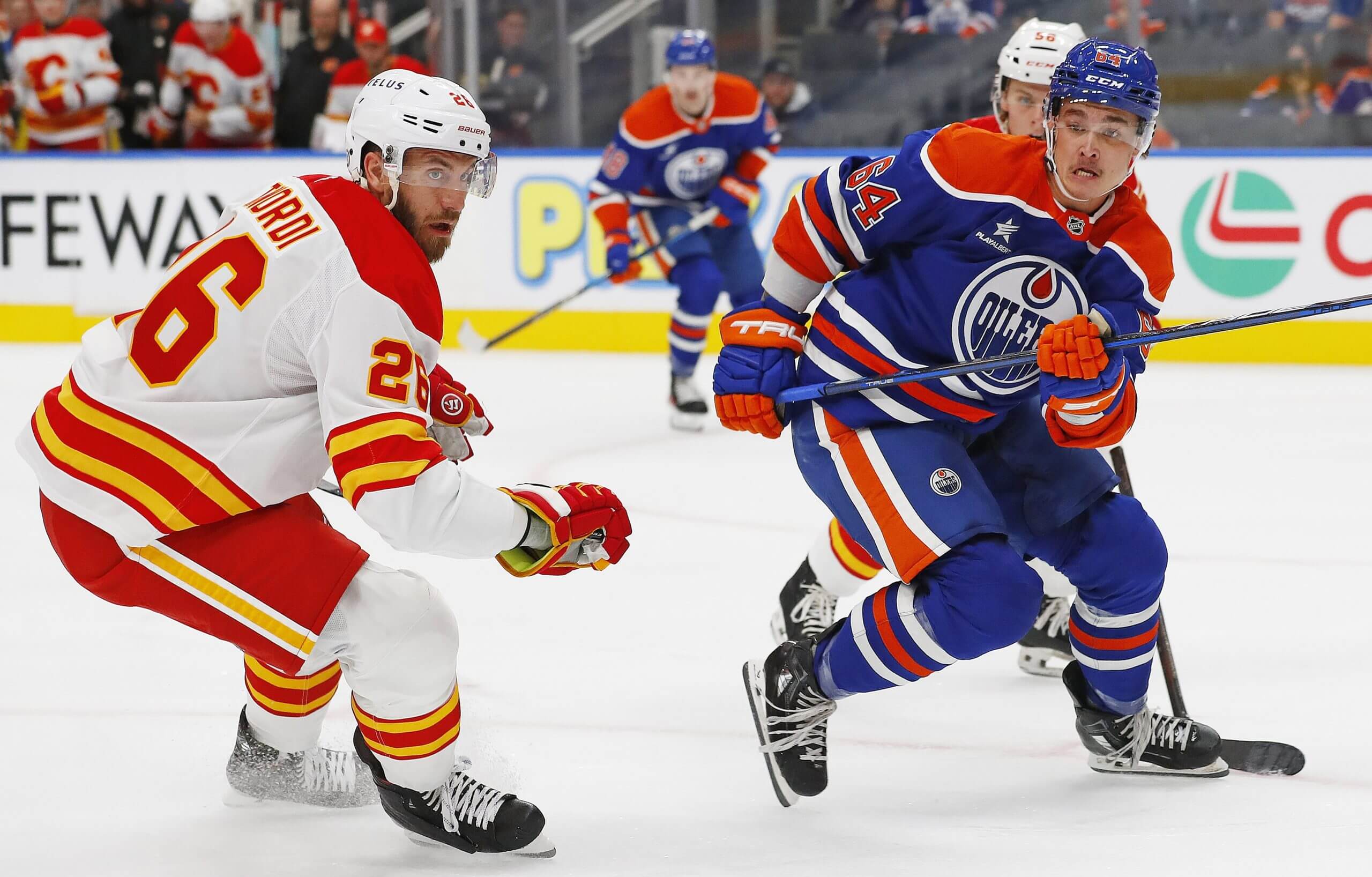Does Edmonton Oilers prospect Connor Clattenburg have an NHL future?

With selected prospect Connor Clattenburg's reputation as a strong two-way player and top body checker in the OHL, bettors might consider the Oilers' likelihood of enhancing their depth with physical play, potentially leading to more favorable betting odds for games where hitting and defensive play could sway results.
Edmonton Oilers selected winger Connor Clattenburg from the OHL’s Flint Firebirds in the fifth round of the 2024 NHL Draft. Draft day scouting reports described a physical winger who hit everything that moved and had some offence. By the fifth round of any draft, teams are looking for players with one outstanding skill, with the understanding that the elite passers and first-shot scorers are long gone. Edmonton liked the rugged aspect of Clattenburg’s resume.
Clattenburg doesn’t fit the profile of a future NHL player. He didn’t appear in my top-20 prospects published after the draft this summer. My list is mostly math-based, assuming that a forward on his way to the Oilers will have to score at least a little to make the grade. In late early winter 2024, the Oilers signed him. That’s a good arrow for any fifth-round selection.
Another piece of good news: Edmonton’s prospect pool doesn’t have many wingers who are 6-foot-5, 203 pounds with a reputation for rattling the boards with heavy hits. A deeper dive offers more intrigue. The OHL coaches poll published this spring had Clattenburg ranked as the top body checker in the league’s Western Conference, and No. 3 in both the best defensive forward and hardest worker categories in the West as well. Body checking and hardest work are interesting, but the best defensive forward votes are the real news. That offers a sliver of hope for a possible NHL future.
Trending up? Bruce Curlock evaluates Oilers prospects using video evidence and tracking progress. Recently, he ranked Clattenburg as his No. 7 prospect, writing, “his skating and size are projectable to a fourth line player who can play hard, physical hockey. I would be quite surprised if he doesn’t get a cup of coffee or two in the NHL. What will make him stick for longer than a large double-double is the development of his puck skills.” Doubling down on the strong ranking was Bob Stauffer from Oilers Now, himself a strong talent evaluator. Stauffer matched Curlock’s opinion, ranking Clattenburg as his No. 7 prospect.
Is Clattenburg the seventh best prospect in the Oilers system? Offence Over many years, the Oilers have drafted physical wingers with the idea of using them in depth (fourth line) roles. Some have been wildly successful, others hung around the league for a time, while still others fell short of the NHL. Here’s a brief and incomplete look at some depth wingers who brought a physical element, checking ability and shy offence to their final seasons of junior hockey.
Offence had little to do with Kelly Buchberger’s NHL career. He was a tireless forechecker who was fearless physically. He became one of the most popular players in team history. Part of that success came due to the rules of the time, which allowed all manner of fights and intimidation. Buchberger killed penalties, blocked shots and earned a long and productive NHL career. His offence was never a strength, and the changing of the rules (instigator) makes him an extreme outlier when discussing modern players. It’s not possible for a Buchberger to exist in 2025.
Mitch Moroz is a better style comparable for Clattenburg. Both men earned strong reputations as checking forwards, and both scored well enough in their final junior seasons to receive NHL contracts from the Oilers. Moroz had an exceptional junior career with the Edmonton Oil Kings, including 35 goals in his final season in the WHL. He didn’t flourish in pro hockey. Part of the issue was offence, as he scored just 14 goals in 147 AHL games. The Oilers weren’t a strong team at the time, and the club was inconsistent in developing players in the AHL. Clattenburg’s offence in the OHL last season and team goal scoring in the league were similar to Moroz coming out of junior. That doesn’t mean he’ll fail in pro hockey, but the Bakersfield Condors coaching staff will need to play him in situations where his skills can be advanced.
Bottom line on offence: Clattenburg will have three seasons of his entry-level deal to post some offence in the minors. The organization showed faith in him by reaching out with a contract. He won’t have the rule advantage that allowed Buchberger to flourish, but will have a more mature development team in Bakersfield than Moroz a decade ago.
The rest of his game Clattenburg’s first AHL season will tell us much about his ability to play a responsible game. He should have a better team to play for than Moroz as an AHL rookie. The final Oklahoma City Barons team bled goals with Moroz on and off the ice. He did improve in Year 2. In 40 games with the 2015-16 Bakersfield Condors, Moroz went 18-14 goals (56 percent). He was unable to build on it, though, and his career faded. For Clattenburg, playing time will be the tell. Moroz didn’t see much action as a rookie, and didn’t see feature minutes on the Barons or Condors. The team chose to run veterans Rob Klinkhammer and Ryan Hamilton on the skill lines. Much of the development comes from an organizational commitment. Clattenburg will need opportunities.
Bottom line Curlock’s comments about Clattenburg’s offensive ability include a passage about advancing his play offensively during the past season. One of the dangers of placing too much importance on a player’s final junior season is physical maturity. Clattenburg would have bossed players a couple of years younger all winter long. Moroz scored 35 goals at 19, after delivering just 13 the previous season. Clattenburg scored 25 goals in his final 76 OHL games over two seasons. The numbers are similar, and the league goal totals are also a match. Neither man dominated at 17 or 18.
Clattenburg’s two-way acumen is a huge positive, and his reputation as a punishing hitter will be welcome. As it always does, this will come down to how much offence will be delivered. When winger Gilles Tremblay arrived at Montreal Canadiens training camp in the fall of 1960, he told coach Toe Blake he could take care of the defensive aspects of the game, but wouldn’t be able to help too much offensively. Blake told him to look after the puck in the Montreal zone, and he’d teach him where goals came from at the other end. It worked well for a decade. That’s what Clattenburg will need. He won’t see feature minutes. He’ll have to score fourth-line goals consistently to make the NHL. We wait.
Clattenburg's two-way acumen is a huge positive, and his reputation as a punishing hitter will be welcome.
The Athletic Football edmonton oilershttps://betarena.featureos.app/
https://www.betarena.com
https://betarena.com/category/betting-tips/
https://github.com/Betarena/official-documents/blob/main/privacy-policy.md
[object Object]
https://github.com/Betarena/official-documents/blob/main/terms-of-service.md
https://stats.uptimerobot.com/PpY1Wu07pJ
https://betarena.featureos.app/changelog
https://twitter.com/betarenasocial
https://github.com/Betarena
https://medium.com/@betarena-project
https://discord.gg/aTwgFXkxN3
https://www.linkedin.com/company/betarena
https://t.me/betarenaen
 Theathleticuk
Theathleticuk